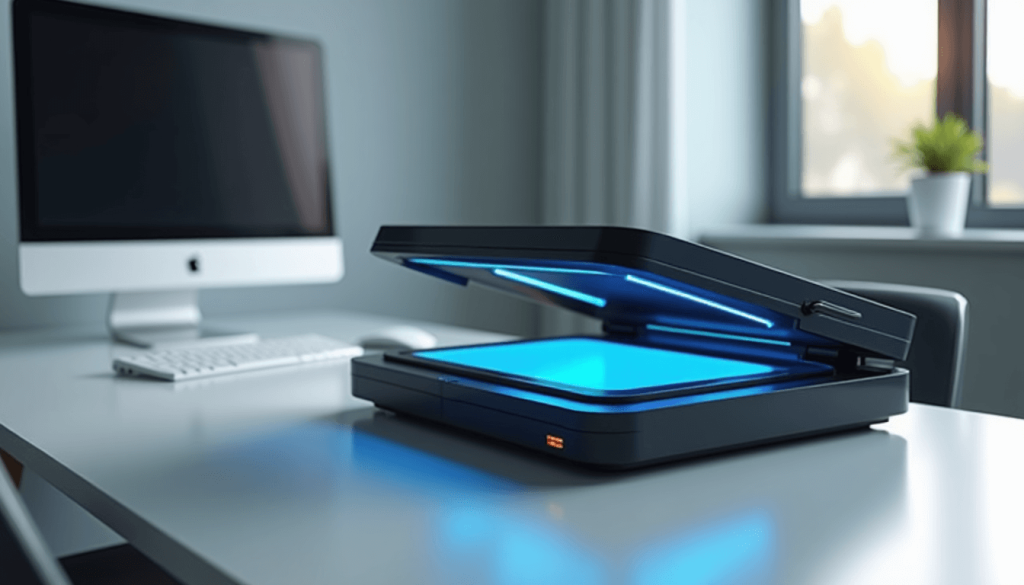Integrating TWAIN Scanning in VB .NET

TWAIN scanning functionality poses notable challenges for VB.NET developers. While the TWAIN protocol offers standardized scanner communication, proper implementation demands careful attention to both framework capabilities and protocol specifications.
Setting up TWAIN scanner features correctly requires specific knowledge of VB.NET framework interactions and TWAIN protocol requirements. This guide explains each step needed to add scanning capabilities to your VB.NET applications, from basic configuration to advanced performance tuning.
The following sections detail fundamental TWAIN architecture concepts specific to VB.NET development.
Understanding TWAIN Architecture for VB.NET Development
TWAIN serves as the foundation for document scanning in software applications. The protocol standardizes the interface between scanning hardware and VB.NET applications, enabling direct image acquisition.
TWAIN Protocol Fundamentals and Data Source Manager
TWAIN uses three main components: the application, Data Source Manager (DSM), and device drivers. The DSM functions as a bridge between VB.NET applications and scanner drivers. TWAIN stands out due to:
- Market presence: Higher adoption rates than WIA, ISIS, and SANE
- Platform support: Compatible with Windows, Mac OS, and Linux/Unix
- Cost efficiency: DSM is LGPL-licensed and free to use
- Advanced features: TWAIN scanners support more capabilities than competing protocols
The DSM manages device detection, connection handling, and data transfer, allowing developers to focus on application logic instead of hardware communication.
VB.NET Framework Compatibility with TWAIN 2.3 Specification
TWAIN 2.3 integrates directly with VB.NET through specialized framework components. Benefits include:
- High-level APIs for ease of development
- Low-level APIs for precise scanner control
- Compatibility with WinForms, WPF, and Web applications
- Support for 32-bit and 64-bit environments
VB.NET developers can implement scanning features without dealing with complex protocol specifics. The framework handles device capability negotiation automatically.
Source-Application Communication Model in .NET
TWAIN communication in VB.NET follows these five steps:
- Application sends requests via the TWAIN .NET component
- Component interacts with the DSM
- DSM relays commands to the device driver
- Driver operates the scanner hardware
- Image data is returned through the reverse path
This model abstracts hardware complexity while providing control over resolution, color depth, and document feeding. The standardized approach ensures compatibility across different scanner models without requiring custom device-specific code.
Implementing Core TWAIN Functionality in VB.NET
Adding TWAIN functionality to a VB.NET application requires a structured codebase and a clear understanding of scanner communication patterns.
Setting Up Project References and Namespace Declarations
Start by adding the required references to your VB.NET project:
- GdPicture.NET SDK for TWAIN integration
- System.Drawing for image processing
Include these namespaces at the top of your code file:
Imports System.Drawing
Imports GdPicture14
Initializing the Data Source Manager in VB.NET
To connect your application with scanner drivers, initialize the Data Source Manager:
Dim gdPictureImaging As New GdPictureImaging()
Dim licenseManager As New LicenseManager()
licenseManager.RegisterKEY("YOUR_LICENSE_KEY")
Device Selection and Connection Implementation
Allow users to select and connect to a scanner:
Dim WINDOW_HANDLE As IntPtr = IntPtr.Zero
If gdPictureImaging.TwainSelectSource(WINDOW_HANDLE) Then
If gdPictureImaging.TwainOpenSource(WINDOW_HANDLE) Then
' Device connected successfully
End If
End If
Configuring Scanner Parameters Programmatically
Set scanner parameters before acquiring an image:
' Set resolution
gdPictureImaging.TwainSetResolution(300)
' Set color mode to RGB
gdPictureImaging.TwainSetPixelType(TwainPixelType.TWPT_RGB)
' Enable duplex scanning
gdPictureImaging.TwainEnableDuplex(True)
Executing the Scanning Operation with Error Handling
Ensure robust error handling during scanning:
Try
Dim imageID As Integer = gdPictureImaging.TwainAcquireToGdPictureImage()
If imageID <> 0 Then
picPreview.Image = gdPictureImaging.GetBitmapFromGdPictureImage(imageID)
gdPictureImaging.ReleaseGdPictureImage(imageID)
Else
Dim resultCode As Integer = gdPictureImaging.TwainGetLastResultCode()
Dim conditionCode As Integer = gdPictureImaging.TwainGetLastConditionCode()
' Handle or log the error using these codes
End If
Catch ex As Exception
MessageBox.Show("Scanning error: " & ex.Message)
Finally
If gdPictureImaging.TwainGetState() >= TwainStatus.TWAIN_SOURCE_OPEN Then
gdPictureImaging.TwainCloseSource()
End If
End Try
Batch Scanning with Automatic Document Feeder
' Enable auto feed
gdPictureImaging.TwainSetAutoFeed(True)
gdPictureImaging.TwainSelectFeeder(True)
While True
Dim imageID As Integer = gdPictureImaging.TwainAcquireToGdPictureImage()
If imageID = 0 Then Exit While
' Process the image
ProcessImage(imageID)
' Release resources
gdPictureImaging.ReleaseGdPictureImage(imageID)
End While
gdPictureImaging.TwainCloseSource()
Conclusion
VB.NET developers can seamlessly integrate TWAIN scanning using GdPicture.NET SDK, leveraging robust API features for high-performance scanning. Your implementation now includes validated methods and enhanced error diagnostics, ensuring reliability in production environments. Implementing best practices such as window handle usage, TWAIN state validation, and detailed error checking contributes to a more robust and maintainable scanning solution.
For further assistance, the GdPicture.NET Support team provides expert guidance on specific TWAIN integration challenges.
FAQ
1. What is TWAIN and why is it important for scanner integration in VB.NET?
TWAIN is a standardized protocol that enables communication between scanning devices and software applications. It’s crucial for VB.NET developers as it provides a consistent interface for integrating document scanning capabilities into their applications, supporting various operating systems and offering sophisticated scanner functionality.
2. How do I initialize the TWAIN Data Source Manager in VB.NET?
To initialize the TWAIN Data Source Manager in VB.NET, you need to add the necessary references to your project, such as the GdPicture.NET SDK. Then, create an instance of the TWAIN-compatible class (GdPictureImaging) and register your license key. Optionally, you can set a window handle to manage UI-based interactions.
3. What are some best practices for configuring scanner parameters in VB.NET?
Set an appropriate resolution based on document type (e.g., 200 DPI for text, 300 DPI for mixed content). Use bitonal mode for speed, grayscale for better quality, and color for graphics. Always enable duplex scanning if supported and needed for double-sided documents.
4. How can I implement batch scanning with an automatic document feeder (ADF)?
Enable auto feed and feeder selection using TwainSetAutoFeed(True) and TwainSelectFeeder(True). Use a loop to continuously call TwainAcquireToGdPictureImage() until it returns 0, signaling no more pages are available.
5. How do I handle errors during scanning?
Use TwainGetLastResultCode() and TwainGetLastConditionCode() to retrieve diagnostic info when an image fails to scan. These codes help identify the cause of the failure and guide appropriate error-handling logic.
6. Can I scan asynchronously to keep the UI responsive?
Yes, while not covered in this guide, you can implement asynchronous scanning using background threads or task-based programming to avoid freezing the UI during long scanning operations.
7. What should I do if the scanner dialog does not appear?
Ensure you’re passing a valid window handle using IntPtr.Zero or the handle to your main form. Some scanners require a parent window to correctly display UI dialogs.
How to Get Started
Integrating GDPicture into your applications is quick and easy. For a customized evaluation and demo, please contact our team of experts, and we will guide you properly for your use-case and requirements.
Alternatively, you can also download it for free.

Hulya is a frontend web developer and technical writer at GDPicture who enjoys creating responsive, scalable, and maintainable web experiences. She’s passionate about open source, web accessibility, cybersecurity privacy, and blockchain.
Tags:
